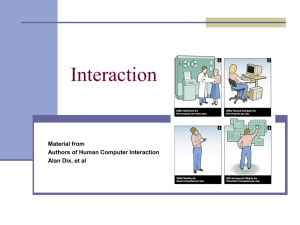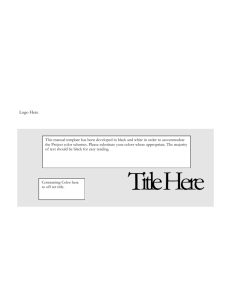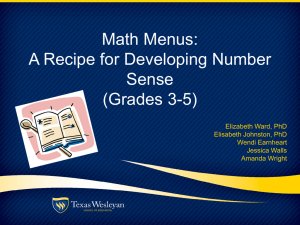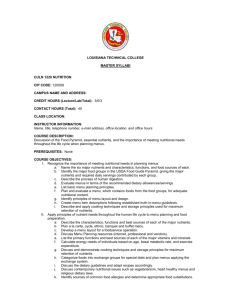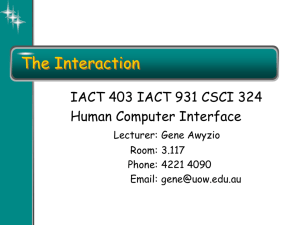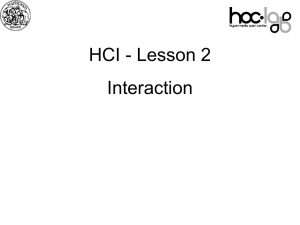chap3
advertisement
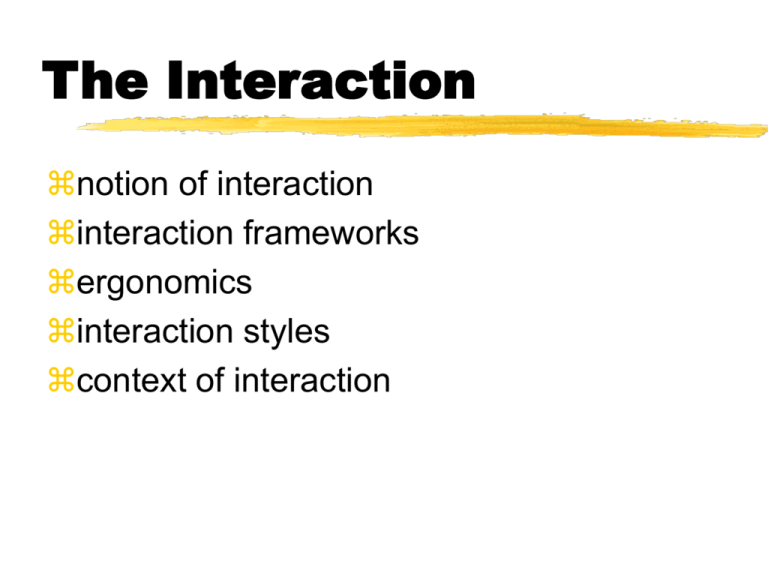
The Interaction notion of interaction interaction frameworks ergonomics interaction styles context of interaction Interaction Frameworks Interaction: communication between the user and the system Why have a framework? • allows contextualisation • presents a global view Interaction Frameworks - 2 Donald Norman’s Interaction framework • user establishes the goal • formulates intention • specifies actions at interface • executes action • perceives system state • interprets system state • evaluates system state with respect to goal Norman’s model concentrates on user’s view of the interface Interaction Frameworks - 3 Some systems are harder to use than others Gulf of Execution user’s formulation of actions actions allowed by the system Gulf of Evaluation user’s expectation of changed system state actual presentation of this state Interaction Frameworks - 4 extended by Abowd and Beale: their interaction framework has 4 parts • user • input • system • output O output S U system user I input each has its own unique language interaction translation between languages problems in interaction = problems in translation Interaction Frameworks - 5 user intentions translated into actions at the interface translated into alterations of system state reflected in the output display interpreted by the user general framework for understanding interaction • • • • not restricted to electronic computer systems identifies all major components involved in interaction allows comparative assessment of systems an abstraction Ergonomics Study of the physical characteristics of interaction Also known as human factors. Ergonomics good at defining standards and guidelines for constraining the way we design certain aspects of systems. Ergonomics - examples • arrangement of controls and displays e.g. controls grouped according to function or frequency of use, or sequentially • surrounding environment e.g. seating arrangements adaptable to cope with all sizes of user • health issues e.g. physical position ), lighting, noise, environmental conditions (temperature, humidity • use of colour e.g. use of red for warning, green for okay, awareness of colour-blindness etc. Interaction styles Interaction: dialogue between computer and user Some applications have very distinct styles of interaction. We can identify some common styles • command line interface • menus • natural language • question/answer and query dialogue • form-fills and spreadsheets • WIMP Command line interface Way of expressing instructions to the computer directly. function keys, single characters, short abbreviations, whole words, or a combination • • • • suitable for repetitive tasks better for expert users than novices offers direct access to system functionality command names/abbreviations should be meaningful Typical example: the Unix system Menus Set of options displayed on the screen Options visible – less recall - easier to use – rely on recognition so names should be meaningful Selected by using mouse, numeric or alphabetic keys Often options hierarchically grouped: sensible grouping is needed Menu systems can be • purely text based, with options presented as numbered choices • graphical selected by arrow keys • graphical selected by mouse • combination (e.g. mouse plus accelerators) Restricted form of full WIMP system Natural language Familiar to user Use speech recognition or typed natural language Problems • vague • ambiguous • hard to do well! Solutions • try to understand a subset • pick on key words Query interfaces Question/answer interfaces • user led through interaction via series of questions • suitable for novice users but restricted functionality • often used in information systems Query languages (e.g. SQL) • used to retrieve information from database • requires understanding of database structure and language syntax, hence requires some expertise Form-fills Primarily for data entry or data retrieval Screen like paper form. Go-faster Travel Agency Data put in relevant place. Bookings Please enter details of journey: Requires • good design • obvious correction facilities Start from: Destination: Via: York Pittsburgh Birmingham First Class/Second Class/Bargain Single/Return Seat Number: Spreadsheets first spreadsheet VISICALC first; followed by Lotus 1-2-3 MS Excel most common today sophisticated variation of form-filling. • grid of cells contain a value or a formula • formula can involve values of other cells e.g. sum of all cells in this column • user can enter and alter data • spreadsheet maintains consistency WIMP Interface • • • • Windows Icons Menus Pointers (or windows, icons, mice, and pull-down menus) default style for majority of interactive computer systems, especially PCs and desktop machines Windows Areas of the screen that behave as if they were independent terminals • • • • • can contain text or graphics can be moved or resized can overlap and obscure each other, or can be laid out next to one another (tiled) scrollbars allow the user to move the contents of the window up and down or from side to side title bars describe the name of the window Icons • small picture or image • represents some object in the interface often a window or action • windows can be closed down (iconised) small representation many accessible windows • icons can be many and various highly stylized or realistic representations. Pointers • important component WIMP style relies on pointing and selecting things • usually achieved with mouse • also joystick, trackball, cursor keys or keyboard shortcuts • wide variety of graphical images Menus Choice of operations or services offered on the screen. Required option selected with pointer File Edit Options Font Typewriter Screen Times • problem - menus can take up a lot of screen space • solution - menu appears when needed Kinds of Menus Menu Bar at top of screen (normally), menu drags down • pull-down menu - mouse hold and drag down menu • drop-down menu - mouse click reveals menu • fall-down menus - mouse just moves over bar! Contextual menu appears where you are • pop-up menus - actions for selected object • pie menus - arranged in a circle - easier to select item (larger target area) - quicker (same distance to any option) … but not widely used! Menus extras Cascading menus • hierarchical menu structure • menu selection opens new menu • and so in ad infinitum Keyboard accelerators • key combinations - same effect as menu item • two kinds - active when menu open - usually first letter - active when menu closed - usually Ctrl + letter - usually different !!! Menus design issues • which kind to use • what to include in menus at all • words to use (action or description) • how to group items • choice of keyboard accelerators WIMP look and feel Lots of things you can interact with: • • • • main WIMP components (windows,menus,icons) buttons dialogue boxes pallettes Collectively known as widgets appearance + behaviour = look and feel Buttons individual and isolated regions within a display that can be selected to invoke an action. Special kinds • radio buttons - set of mutually exclusive choices • check boxes - set of non-exclusive choices dialogue boxes information windows that pop up to inform of an important event or request information. E.g: when saving a file, a dialogue box is displayed to allow the user to specify the filename and location. Once the file is saved, the box disappears. Pallettes and tear-off menus Problem • menu not there when you want it Solution • tear-off off and pin-up menus stay around when • pallettes little windows of actions shown/hidden via menu option e.g. available shapes in drawing package Social and Organizational Context Interaction affected by social and organizational context • other people - desire to impress, competition, fear of failure • motivation - fear, allegiance, ambition, self-satisfaction • inadequate systems cause frustration and lack of motivation
